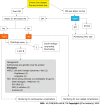Clinical implications of diabetes in chronic liver disease: Diagnosis, outcomes and management, current and future perspectives
- PMID: 35317103
- PMCID: PMC8900578
- DOI: 10.3748/wjg.v28.i8.775
Clinical implications of diabetes in chronic liver disease: Diagnosis, outcomes and management, current and future perspectives
Abstract
Diabetes mellitus (DM) is common in liver cirrhosis (LC). The pathophysiological association is bidirectional. DM is a risk factor of LC and LC is a diabetogenic condition. In the recent years, research on different aspects of the association DM and LC has been intensified. Nevertheless, it has been insufficient and still exist many gaps. The aims of this review are: (1) To discuss the latest understandings of the association of DM and LC in order to identify the strategies of early diagnosis; (2) To evaluate the impact of DM on outcomes of LC patients; and (3) To select the most adequate management benefiting the two conditions. Literature searches were conducted using PubMed, Ovid and Scopus engines for DM and LC, diagnosis, outcomes and management. The authors also provided insight from their own published experience. Based on the published studies, two types of DM associated with LC have emerged: Type 2 DM (T2DM) and hepatogenous diabetes (HD). High-quality evidences have determined that T2DM or HD significantly increase complications and death pre and post-liver transplantation. HD has been poorly studied and has not been recognized as a complication of LC. The management of DM in LC patients continues to be difficult and should be based on drug pharmacokinetics and the degree of liver failure. In conclusion, the clinical impact of DM in outcomes of LC patients has been the most studied item recently. Nevertheless many gaps still exist particularly in the management. These most important gaps were highlighted in order to propose future lines for research.
Keywords: Clinical implications; Diabetes mellitus; Hepatogenous diabetes; Liver cirrhosis; Therapy.
©The Author(s) 2022. Published by Baishideng Publishing Group Inc. All rights reserved.
Conflict of interest statement
Conflict-of-interest statement: Pugliese G reported lecture fees from Novo Nordisk, Astra-Zeneca, Eli-Lilly. The other authors have no conflict to declare.
Figures



Similar articles
-
Managing diabetes and liver disease association.Arab J Gastroenterol. 2018 Dec;19(4):166-179. doi: 10.1016/j.ajg.2018.08.003. Epub 2018 Nov 9. Arab J Gastroenterol. 2018. PMID: 30420265 Review.
-
Hepatogenous diabetes: Knowledge, evidence, and skepticism.World J Hepatol. 2022 Jul 27;14(7):1291-1306. doi: 10.4254/wjh.v14.i7.1291. World J Hepatol. 2022. PMID: 36158904 Free PMC article. Review.
-
Liver cirrhosis and diabetes: risk factors, pathophysiology, clinical implications and management.World J Gastroenterol. 2009 Jan 21;15(3):280-8. doi: 10.3748/wjg.15.280. World J Gastroenterol. 2009. PMID: 19140227 Free PMC article. Review.
-
Association between Liver Cirrhosis and Diabetes Mellitus: A Review on Hepatic Outcomes.J Clin Med. 2021 Jan 12;10(2):262. doi: 10.3390/jcm10020262. J Clin Med. 2021. PMID: 33445629 Free PMC article. Review.
-
Hepatogenous diabetes: Is it time to separate it from type 2 diabetes?Liver Int. 2017 Jul;37(7):950-962. doi: 10.1111/liv.13337. Epub 2016 Dec 31. Liver Int. 2017. PMID: 27943508 Review.
Cited by
-
Transition from acute kidney injury to chronic kidney disease in liver cirrhosis patients: Current perspective.World J Nephrol. 2025 Mar 25;14(1):102381. doi: 10.5527/wjn.v14.i1.102381. World J Nephrol. 2025. PMID: 40134649 Free PMC article. Review.
-
Intermittent fasting and the liver: Focus on the Ramadan model.World J Hepatol. 2024 Aug 27;16(8):1070-1083. doi: 10.4254/wjh.v16.i8.1070. World J Hepatol. 2024. PMID: 39221099 Free PMC article.
-
Evaluation of Vinca Rosea's Protective Effects on Hepatic Function in Streptozotocin-Induced Diabetic Wistar Albino Rats.Cureus. 2024 Nov 21;16(11):e74166. doi: 10.7759/cureus.74166. eCollection 2024 Nov. Cureus. 2024. PMID: 39712809 Free PMC article.
-
[Hepatogenic diabetes: three cases report and literature review].Probl Endokrinol (Mosk). 2025 May 20;71(2):66-74. doi: 10.14341/probl13443. Probl Endokrinol (Mosk). 2025. PMID: 40411331 Free PMC article. Review. Russian.
-
Metformin in Antiviral Therapy: Evidence and Perspectives.Viruses. 2024 Dec 18;16(12):1938. doi: 10.3390/v16121938. Viruses. 2024. PMID: 39772244 Free PMC article. Review.
References
-
- Conn HO, Schreiber W, Elkington SG, Johnson TR. Cirrhosis and diabetes. I. Increased incidence of diabetes in patients with Laennec's cirrhosis. Am J Dig Dis. 1969;14:837–852. - PubMed
-
- Vido I, Valovicová E, Belajová E. [Hepatogenic diabetes] Munch Med Wochenschr. 1969;111:1898–1902. - PubMed
-
- Bianchi G, Marchesini G, Zoli M, Bugianesi E, Fabbri A, Pisi E. Prognostic significance of diabetes in patients with cirrhosis. Hepatology. 1994;20:119–125. - PubMed
-
- Holstein A, Hinze S, Thiessen E, Plaschke A, Egberts EH. Clinical implications of hepatogenous diabetes in liver cirrhosis. J Gastroenterol Hepatol. 2002;17:677–681. - PubMed
-
- Wlazlo N, Beijers HJ, Schoon EJ, Sauerwein HP, Stehouwer CD, Bravenboer B. High prevalence of diabetes mellitus in patients with liver cirrhosis. Diabet Med. 2010;27:1308–1311. - PubMed
Publication types
MeSH terms
LinkOut - more resources
Full Text Sources
Medical

